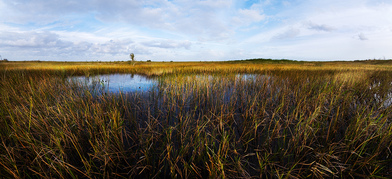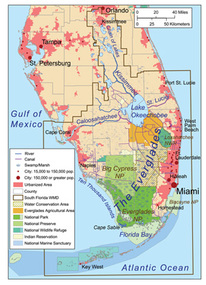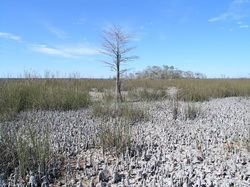 Most people think of water when they think of the Everglades: a "swamp," or, as environmentalist Marjory Stoneman Douglas called it, a "River of Grass". However, the Everglades has two distinct seasons: "wet" and "dry". South Florida's subtropical to tropical climate has a seven month long "wet season" from April through October. Only a quarter of yearly rainfall takes place during the "dry season" (November-March). The Everglades are affected not just by the rain that falls on them almost daily throughout the summer, but by the complex hydrology of Florida. Rain that falls in Central Florida floods into Lake Okeechobee and once the lake is at capacity, begins a slow journey southward towards Florida Bay. The shallow, slow-moving river formed by this water is called sheetflow, and may take months or sometimes years to reach Florida Bay, as water may subside and be stored in porous limestone bedrock from one "wet" season to the next.  One of the greatest threats to the survival of the Everglades has been the impact of humans on this natural hydrological cycle. As the population of Florida has risen, water has been diverted to protect homes and property and to create agricultural land, as well as for human use. While Everglades restoration seeks to return some of the natural flow, the Everglades as they currently exist are severely curtailed. The pressures created by human development have dramatically changed the Everglades: they now cover only about 50 percent of their former area, and under new conditions scientists have observed changes in commercial fisheries, seagrass beds, coral reef health, and 85 to 90 percent declines in the populations of wading birds which call the Everglades home.  The dry season in the Everglades is the busiest tourist season, as cooler temperatures, fewer insects, and the concentration of wildlife around available water sources make viewing wildlife simpler and more comfortable. However, the slow movement of sheetflow (traveling approximately a half-mile per day) and the explosion of life that accompanies the abundance of water makes a summer visit equally rewarding. The awesome photos you see here are courtesy of the National Park Service, the folks who take care of and protect a lot of our national heritage. If you'd like to check out more of the amazing photos they share--along with a lot of other great stuff, including the Anhinga webcam and neat facts about the park, please visit them here: http://www.nps.gov/ever/photosmultimedia/index.htm.
4 Comments
Taylor
12/8/2021 01:26:21 pm
Umm.... What are the water levels???
Reply
8/22/2023 05:46:17 am
Just read this article and I can say these are awesome great tips on how to take care of your USF Moving Company. I will be using this tips for my own clients so that there USF Moving Company in Houston, TX go smoothly!
Reply
4/7/2024 01:41:26 pm
Awesome article, if you want to support companies that care about their environment, check out Eliott's Moving Company in Houston, TX!
Reply
Leave a Reply. |
Field Notes
Archives
July 2021
Categories |
|
Partner with us! We are always looking for new schools, scientists, and non-profit organizations to partner with. Please contact us here to start a conversation.
Hear from us! Sign up for our newsletter to hear about what is happening at Field School as well as upcoming offers and specials. |

 RSS Feed
RSS Feed